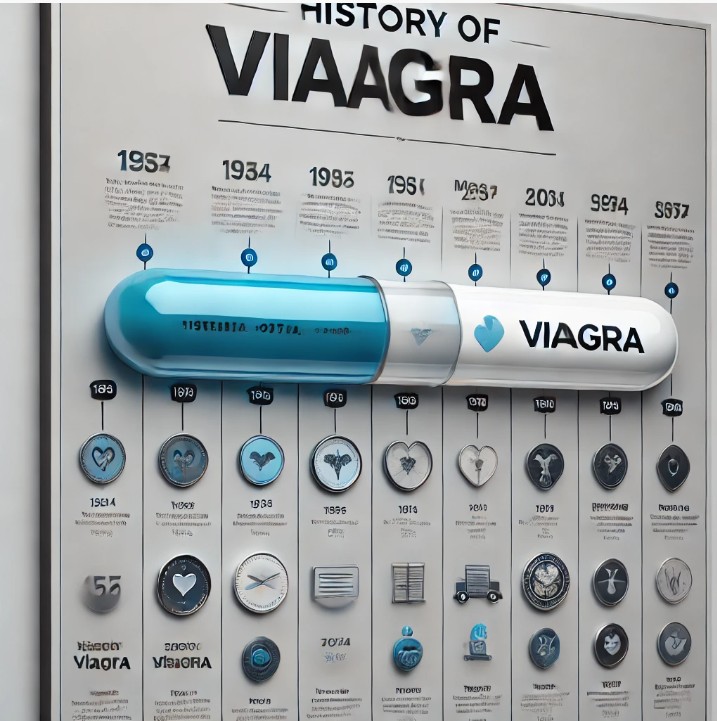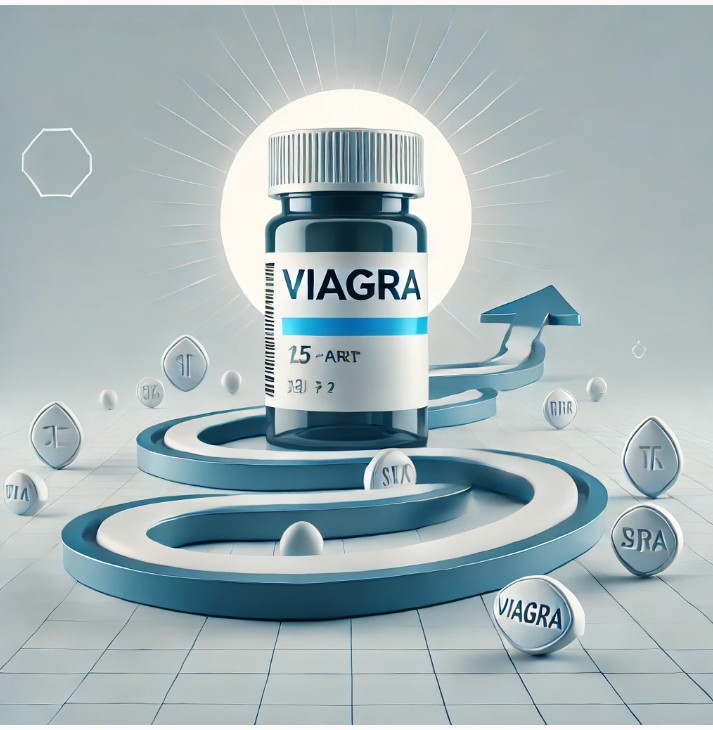
Erectile dysfunction (ED) is a condition that affects millions of men around the world, but it wasn’t always easy to find a safe and effective treatment. Before Viagra (sildenafil citrate) entered the scene, men dealing with ED often resorted to injections, pumps, or other invasive treatments. Viagra changed the game by providing a non-invasive, effective solution.
Today, Viagra is recognized as one of the most successful drugs in modern medicine, and its development story is one of science, innovation, and clinical success. This article will delve into the history of Viagra, tracing its journey from the early research labs to its position as a global leader in ED treatment.
The Birth of Viagra: The Early Years of Discovery
The history of Viagra begins in the early 1990s, when scientists at Pfizer, a major pharmaceutical company, were searching for a way to treat high blood pressure and angina (chest pain). Their initial research focused on a compound called sildenafil, which was developed to improve blood flow in the arteries and veins. The goal was to create a medication that would help improve heart function, but what they didn’t expect was that sildenafil would have an entirely different effect—on the blood vessels in the penis.
As part of the research, Pfizer ran clinical trials to test the compound’s effectiveness for heart conditions. However, early clinical trials revealed something surprising: the patients taking sildenafil experienced an improvement in their ability to get and maintain an erection. This discovery led Pfizer to shift its focus from treating heart conditions to the much-needed treatment of erectile dysfunction.
The Unintended Discovery: A Breakthrough for Erectile Dysfunction
In the early days of Viagra’s journey, the discovery that sildenafil could help men with ED was purely accidental. Pfizer’s researchers had no intention of creating a medication for sexual health, but the clinical trial results were undeniable. After conducting tests and analyzing the effects of the compound, researchers found that sildenafil effectively increased blood flow to the penis, making it easier for men to achieve and maintain an erection when sexually stimulated.
This breakthrough provided an opportunity to address a growing need. Erectile dysfunction was a condition that, until that point, was often treated with invasive procedures like penile injections, pumps, or surgery. There was clearly a demand for a non-invasive, reliable treatment option, and Viagra fit the bill.
Viagra’s Journey to Becoming a Treatment for ED
Once Viagra‘s unexpected benefits were recognized, Pfizer pivoted to focus on developing it as an ED treatment. The company conducted additional clinical trials to determine the safety and effectiveness of Viagra in men with erectile dysfunction. The results were groundbreaking.
The Phase II clinical trials confirmed that Viagra was highly effective for treating ED. These trials showed that sildenafil could help men with ED achieve and maintain an erection in response to sexual stimulation. With these promising results, Pfizer launched large-scale Phase III trials, which focused on validating the medication’s long-term effectiveness and safety.
Viagra’s Clinical Trial Success: Proving the Effectiveness
The success of Viagra in clinical trials is one of the most significant aspects of its development. The drug went through several stages of rigorous testing, each designed to evaluate its safety, efficacy, and potential side effects.
- Phase I Trials – The first phase of clinical testing for Viagra involved healthy volunteers and focused on determining the drug’s safety and proper dosage levels. Results showed that sildenafil was safe and well-tolerated, without major side effects.
- Phase II Trials – During this stage, Viagra was tested on men with erectile dysfunction. The clinical trial results were nothing short of extraordinary. Men who took Viagra reported significant improvements in their ability to get and maintain an erection. Most importantly, the trials showed that Viagra could help men with ED who had not responded to other treatments.
- Phase III Trials – The final phase of clinical trials was pivotal in securing Viagra‘s approval for public use. In these large-scale trials, Viagra was tested on thousands of men worldwide, in different age groups and with various underlying health conditions. The results confirmed Viagra‘s safety and effectiveness in treating ED, leading to its approval by regulatory bodies like the FDA in 1998.
Viagra’s Approval and Market Launch: A Revolutionary Moment

The FDA’s approval of Viagra in 1998 marked a pivotal moment in the history of Viagra and the treatment of erectile dysfunction. Viagra was the first oral medication approved for ED, and its release to the market was groundbreaking. For the first time, men with ED had an easy, non-invasive, and highly effective treatment option.
Once approved, Viagra quickly gained popularity, with millions of men around the world turning to the pill as a solution for their sexual health concerns. Viagra revolutionized the way ED was treated and changed the landscape of sexual health for men. No longer did men have to rely on uncomfortable and invasive treatments like injections or pumps.
Viagra‘s success wasn’t just in its clinical efficacy—it was in its ability to empower men to address a previously stigmatized condition openly and confidently. By normalizing conversations around ED, Viagra paved the way for further innovations in the field of sexual health.
Ongoing Clinical Research: Viagra’s Continued Legacy
Even after its approval and success, Viagra’s journey didn’t stop. Pfizer continued to conduct clinical trials and research to further assess Viagra’s long-term safety, potential new uses, and how it could be further improved.
- New Uses and Indications – One of the most notable findings from continued research is that Viagra can also treat pulmonary arterial hypertension (PAH), a condition that causes high blood pressure in the lungs. Research into other potential uses for Viagra continues today, with ongoing studies into its effects on conditions like heart disease and diabetes.
- Long-Term Safety Studies – Studies have been conducted to evaluate the long-term safety of Viagra use. These studies have shown that Viagra is safe for most men and does not lead to any significant long-term health risks when used as directed.
- Exploring Alternative Formulations – Research into alternative formulations of Viagra, such as topical gels or lower-dose versions, has also been part of the ongoing clinical trials, ensuring that men of all ages and health conditions can benefit from the medication.
Viagra and Its Impact on Men’s Health and Society
The history of Viagra is also one of societal change. By giving men with ED a reliable and effective solution, Viagra helped break down the stigma surrounding sexual health issues. ED became a condition that could be treated easily and discreetly, which empowered millions of men to take control of their health and quality of life.
Viagra’s journey has not only changed how we view ED but also revolutionized the pharmaceutical industry. Its success has paved the way for other erectile dysfunction medications, such as Cialis and Levitra, which now offer men more choices in how they address ED.
Viagra’s Legacy in the Pharmaceutical Industry
Viagra’s success has had a lasting impact on the pharmaceutical industry. It’s a prime example of how innovation and clinical research can come together to solve a widespread problem. It has not only improved the lives of millions of men but also driven forward the science of erectile dysfunction and sexual health treatments.
Beyond ED, Viagra’s journey has also influenced the development of medications for other conditions, and Pfizer continues to innovate in the realm of men’s health.
Frequently Asked Questions (FAQs)
How did Viagra get its name?
Viagra was chosen as a name to convey strength and power, stemming from the word “Vigour,” to reflect the medication’s ability to help men regain their sexual confidence.
Is Viagra safe for everyone?
While Viagra is generally safe for most men, those with certain health conditions, like heart disease or low blood pressure, should consult a healthcare provider before using it.
Can Viagra be used long-term?
Yes, Viagra is safe for long-term use under the guidance of a healthcare provider. Regular check-ups are recommended to monitor effectiveness and safety.
The Enduring Legacy of Viagra

Viagra’s journey has been a testament to the power of science, innovation, and clinical research.
From its accidental discovery to its status as a global solution for ED, Viagra has changed millions of lives and has a place in history as one of the most successful pharmaceutical products ever developed.
As ongoing research continues to unfold, Viagra remains a symbol of progress in men’s health, and its legacy will continue to impact generations to come.
